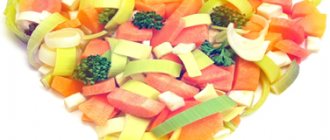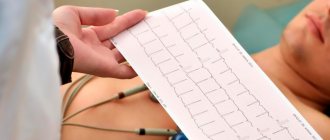September 3, 2010
Doctors are confident that a special diet can improve blood circulation and cope with the first signs of heart disease.
The heart is the only muscle in the body that works continuously and pumps blood, which supplies nutrients and oxygen to the entire body. How effectively it will work also depends on what we eat. Doctors are confident that the nutritional system developed a long time ago called “diet No. 10” can improve blood circulation and cope with the first signs of heart disease.
Basic principles of nutrition for cardiovascular diseases:
1. Eliminate foods that excite the nervous system from your diet
.
Firstly, there is caffeine and caffeinated drinks: cocktails, energy drinks and even all kinds of colas. They increase the heart rate, further loading the heart muscle. Doctors include strong tea, rich broths and dishes containing large amounts of spices as stimulating foods. 2. Reduce your intake of animal fat
.
Fatty foods of animal origin - canned meat, pork, fatty poultry, all types of offal, sausages, smoked meats and lard - are rich in harmful cholesterol, which is deposited in blood vessels in the form of plaques. They can disrupt blood flow, including in the vessels that supply the heart itself. But there is still room on the menu for lean veal, rabbit, chicken and turkey. Boil, steam or bake - any cooking method that does not add additional fat will do. 3. Reduce the amount of salt in your diet
.
This will reduce the amount of fluid that is retained in the body and reduce the load on the heart, which is forced to pump an increased volume of blood. High blood pressure, in particular, develops due to fluid retention. Try to avoid pickles and marinades, and do not buy ready-made sauces, smoked meats and sausages. For the same reason, it is better to avoid fast food, snacks and processed foods, which often have a high salt content. 4. Add Omega-3 fatty acids to your diet
.
These beneficial substances help reduce cholesterol levels in the body, prevent the process of blood clots and lower blood pressure. Omega-3 is most abundant in vegetable oils and fish oil. Experts recommend choosing not too fatty fish and seafood. It is best to boil them, but you can also fry them without fat. But salted, smoked and canned fish are harmful to the heart due to excess salt content. 5. Eat small meals
. In heart disease, a full stomach and bloating lead to irritation of the autonomic nerves responsible for the functioning of the heart. And this, in turn, leads to interruptions in its work. Doctors believe that 4-5 small meals during the day will be easily digested and will not create additional stress on the nervous, and, therefore, cardiovascular system.
Who else needs to adhere to the “Table No. 10” regime?
A balanced diet should be maintained on an ongoing basis. Some categories of people especially need a therapeutic diet:
- Hypertensive patients
. People suffering from high blood pressure are susceptible to vasoconstriction. A high cholesterol level can cause their obstruction, settling on the vascular walls in the form of plaques. This category of patients needs to carefully monitor their diet, avoiding prohibited foods. - Diabetics
. If the patient is at risk for diabetes, then his diet consists of constantly calculating the glycemic index of foods. Table No. 10 includes low GI ingredients.
The normal level of total cholesterol changes with age. If in children and young people it varies from 3.1 to 5 mmol/l, then in a person over 50 years old, 6 mmol/l is considered normal. Elderly people with borderline indicators should monitor their diet when switching to a therapeutic diet.
Diet No. 10 - do's and don'ts
| Can | It is forbidden |
| Dietary salt-free bread, toast, white bread croutons | Fresh bread, pancakes, pancakes, baked goods |
| Vegetable soups with cereals, milk soups | Broths from meat, poultry, fish, mushrooms. Soups with legumes |
| Lean beef, veal, rabbit, chicken, turkey. Boiled or baked without fat | Fatty meat, geese, ducks, offal, sausages, smoked meats, lard and corned beef, canned meat |
| Lean fish and seafood - boiled or steamed | Fatty fish, salted, smoked fish, caviar, canned fish |
| Milk, low-fat cottage cheese, yogurt, kefir | Salty and fatty cheese, sour cream, cream |
| Soft-boiled eggs, omelettes. No more than 1 egg per day | Fried eggs, hard-boiled eggs |
| Cereal dishes, pasta made from durum flour | Legumes |
| Boiled and baked vegetables. Raw vegetables rarely and carefully | Pickled, salted vegetables. Radishes, onions, garlic, mushrooms, radishes, green peas, cabbage |
| Fresh ripe fruits and berries, honey, jam, dried fruits | Fiber fruits, chocolate, cakes |
| Weak tea, fruit and vegetable juices | Natural coffee, cocoa, strong tea, alcohol |
| Vegetable oils, occasionally unsalted butter | Cooking fats and margarines, lard |
Tags:
- Heart and blood vessels
- Diets
- Caffeine
- Nervous system
- Cellulose
- Therapeutic diets
• To leave a comment you must be an authorized user
- RashaDi In a word - all natural. It’s precisely in semi-finished and processed foods that there is a huge amount of cholesterol and trans fats that accumulate in the body, increase fat deposits, and negatively affect the functioning of the cardiovascular system. I order Atheroclefit Bio on the website phytomarket.ru and take it as a course. The composition is natural, for example, dioscorea extract, supports the health of blood vessels, cleanses their walls of bad cholesterol.
- senezh _Bu__, only your attending physician can advise you on diet and measures to treat your bradycardia. We will not advise you anything here in absentia.
- _Bu__ Question to the specialists representing the site - on “Diet No. 10 - do’s and don’ts”: 1. Why can’t fresh vegetables be allowed? - it would seem that everyone knows that this is healthy food, take it and eat as much as you like. 2. In the same place - why not legumes, mushroom broths, fatty fish, fish broths? (does this refer to ear by the way?) 3. How hard to toast regular black rye bread to make toast in a standard toaster? (minute scale-roller) 4. What is the diet and necessary measures for blood pressure 114\64, pulse 64-69? Bradycardia?
- helluva why can’t legumes and fruits with coarse fiber?
- lastmac without salt our body will die, we need salt
- BUKA_ I’ve been on this diet for about 2 weeks... I'm used to eating without salt... =)
- I liked Colorized 5 basic principles, they are generally doable. But diet No. 10 is very strict, I will start following this if something really hurts, but it’s unlikely to be used as a preventive measure. I’m not yet ready to give up raw vegetables, chicken soup, onions, mushrooms, cheese, beans, salmon.
Sample menu for the week
The cholesterol-lowering diet aims to reduce cholesterol through a balanced diet. It is intended for home use. There are a large number of recipes that will make it healthy and varied. Sample menu for the week:
| Mon | W | Wed | Thu | Fri | Sat | Sun | |
| Breakfast | oatmeal - 100g; sandwich with cheese or a thin layer of butter; tea without sugar. | pearl barley porridge with milk; cottage cheese (mild sweetness); black tea with lemon. | steam omelette; chicory or black tea with lemon. | wheat porridge with milk (low-fat); juice diluted with water. | millet porridge; tea. | oatmeal on water; juice. | cottage cheese and berry casserole; chicory. |
| Snack | Fresh fruit (apple/pear/orange) | Berries (50-100 g) | Apple and pear puree | Orange | Apple | Cottage cheese with berries | Carrot pudding |
| Dinner | noodle soup with secondary broth; fish cutlet (low-fat) - 100 g; dried bread, compote. | beef broth soup; stewed cabbage; steam cutlet; apple compote. | peasant soup with recycled broth; pearl barley with beef goulash. fruit drink | stewed vegetables; bread; chicken fillet cutlet; compote. | borsch; boiled fish; compote. | cabbage soup; stewed vegetables; boiled chicken; compote. | vegetable soup; boiled poultry meat; stew; fruit drink |
| Afternoon snack | Milk soup with cereals (no sugar) | 2 oatmeal cookies (homemade); compote or juice diluted with water. | Baked apple with curd filling | rosehip decoction; 2 Croquette cookies | Morse | oat cookies; rosehip decoction. | Compote |
| Dinner | Vegetable salad (vinaigrette), tea (green) | boiled chicken meat (from the breast); raw vegetable salad, tea. | boiled beef; vitamin salad from cabbage and carrots; juice diluted with water. | pearl barley porridge; kefir (low fat). | risotto; tea. | steamed beef cutlet; salad; tea. | meat soufflé; juice. |
It is necessary to include seafood, fish and nuts in your diet (up to 30 g per day). The menu should change every week. You can add additional ingredients to dishes, make baked goods from oatmeal, coconut, or rice flour.
The last meal is taken no later than 2 hours before bedtime.
In the first half of the day, the calorie intake is much higher than in the second. Dinner consists of light foods.
The effect of diet on the intestines
Proper nutrition helps maintain normal internal balance of the intestines. Diet number 3 for constipation is aimed at improving and stimulating the basic functions of the intestinal microflora, such as:
- synthesis of amino acids and vitamins K and C, as well as B vitamins;
- local immune defense of the body;
- enzymatic processing of dietary fiber;
- neutralization of toxins;
- maintaining the secretory activity of the gastrointestinal tract.
Diet number three restores the functional activity of the intestines, normalizes metabolic processes, improves motility and secretion of intestinal glands. The diet prevents fermentation and the formation of gases, promotes the elimination of toxic compounds, and also normalizes fluid exchange. The healing table ensures normal digestion and timely bowel movements.
Expert opinion
A lipid-lowering diet should be used as part of the treatment of certain diseases under the direct supervision of a physician. It plays a supporting role, but not a determining one. Without appropriate therapy, it is impossible to cure, for example, heart disease with diet alone. Such pathologies should be treated exclusively in a hospital setting under constant supervision. As for weight correction, you definitely shouldn’t expect great results from a lipid diet. It is generally impossible to maintain a low-calorie diet for a long time without medical indications. The best option for losing weight is proper nutrition, physical activity and the ability to control eating habits.
How to get out of a diet
If the lipid-lowering diet is a temporary phenomenon in your life, then you need to take care of its proper termination. A gentle, smooth exit from the diet is the basic rule for maintaining the achieved result. A competent exit means a gradual return to a normal diet. But in order to maintain the achieved weight, it is advisable to continue to adhere to the basic principles of the diet, for example, fractional meals. It is recommended to follow the “80 out of 100” rule. This means that 80% of the diet should coincide with the routine of the technique, and the remaining 20% will be taken up by the usual lifestyle.
Recipes
A small selection of interesting recipes for a lipid diet:
- Carrot cheesecakes. The main ingredient is a package of low-fat cottage cheese. You will also need carrots, a couple of tablespoons of flour, semolina, 1 protein, 0.5 cups of low-fat milk, a little salt, olive oil. Carrots need to be grated on a fine grater. Then add semolina with milk and cottage cheese and put it on low heat in a saucepan. After cooling, protein, salt and flour are added and the dough is kneaded. Bake the formed cheesecakes in the oven.
- Apple semolina pudding. Chop the peeled apples. Next, cook milk semolina porridge, then add protein, salt and butter to it. After mixing all the ingredients, beat with a mixer. Place the mixture on a baking sheet or in a mold and bake in the oven for forty minutes.
- Omelet with mushrooms and vegetables. Beat several chicken eggs, adding salt and sour cream. Chop the spinach and some of the mushrooms and add them to the egg mixture. Pour the resulting mixture into the mold and bake in the oven. Once crust has formed, sprinkle the remaining mushrooms on top and bake for another ten minutes. Before serving, you can garnish with fresh herbs.
- Radish and celery salad. Cut the radishes and celery stalks into slices. Finely chop the onion. Mix all the vegetables and season with natural yogurt. Some people like to sprinkle sesame seeds on their salad.
Basic Rules
The basic rules of the lipid-lowering weight loss method differ little from other diets. In principle, this is simply a program of proper nutrition, in which you need to exclude easily digestible carbohydrates and foods containing large amounts of cholesterol: butter, lard, fermented milk products, processed foods, cheeses, smoked meats.
General rules:
- fractional meals in small portions (5-6 times a day, 200-250 g);
- dinner or snack three hours before bed;
- give preference to boiling, stewing and steaming;
- create a diet with a daily amount of calories – 1200-1300 kcal;
- adhere to the correct drinking regime;
- reduce salt intake;
- replace animal fats with vegetable ones;
- eat rye or whole grain bread.
Below you will find a list of prohibited and permitted foods, thanks to which you can create a diet that allows you to eat a varied diet. This is especially important for people who are indicated to adhere to a diet constantly.
Authorized Products
Diet No. 3 for constipation is aimed at increasing the proportion of foods that enhance colon motility, namely:
- containing organic acids in large quantities: sauerkraut, citrus fruits, fruit drinks from sour berries and fruits, fermented milk drinks;
- with a high content of plant fiber: dried fruits, bran, cereals, wholemeal bread, raw vegetables (spinach, cabbage, radishes, carrots, etc.);
- cold first courses and desserts: okroshka, beetroot soup, ice cream;
- stringy lean meat: veal, rabbit, turkey, beef;
- lean fish: hake, cod, as well as any seafood;
- compotes, weak tea, chicory, rosehip decoction, natural juices.
The diet includes the inclusion in the diet of products with a laxative effect, as well as those that stimulate intestinal motility, such as honey, grapes, sweet apples, peaches, pumpkin, dates. Softening stool is facilitated by eating foods that swell in the digestive tract and facilitate the process of bowel movement.
Dietary fiber contained in cereals, vegetables and fruits is not digested. They absorb toxins and other harmful substances and activate peristalsis. Organic acids inhibit the growth of pathogenic microflora, increase the contractility of the intestinal muscles and normalize stool.
Diet No. 3 involves eating beets, cucumbers, tomatoes, zucchini, cauliflower, and broccoli. For constipation, it is allowed to add green peas and white cabbage to the diet. It is advisable to include fresh cottage cheese, sour cream, as well as fermented milk drinks in the five-day or seven-day menu: yogurt, kumiss, fermented baked milk or drinking yogurt.
If you have problems with bowel movements, you need to eat more berries and fruits containing plant fiber and sugar. For example, nectarines, apricots, plums, melons, watermelons. It is allowed to eat mild cheeses, scrambled eggs, and cream. For sweets, it is better to choose marshmallows, marmalade, jelly, and marshmallows.
You can and should add parsley, dill, cilantro and other greens to your food. Food must be cooked in vegetable or butter. Table No. 3 is quite diverse.
Low-fat diet: prohibited foods
The most strict version of a low-fat diet involves reducing the amount of fat to 10% of the daily diet.
A low-fat diet involves excluding the following foods:
- fat meat;
- fried foods;
- chocolate;
- fatty dairy products;
- seafood;
- sugar and sweet baked goods;
- fatty sauces;
- condensed milk;
- margarine, spread, back fat;
- sausages, wieners, bacon;
- fast food.







